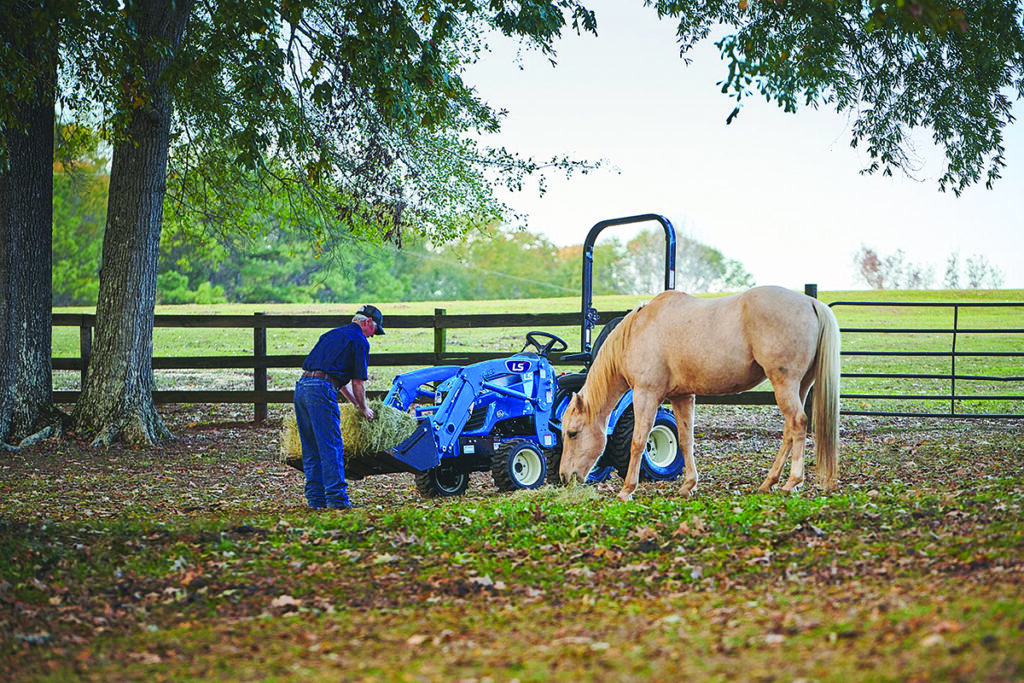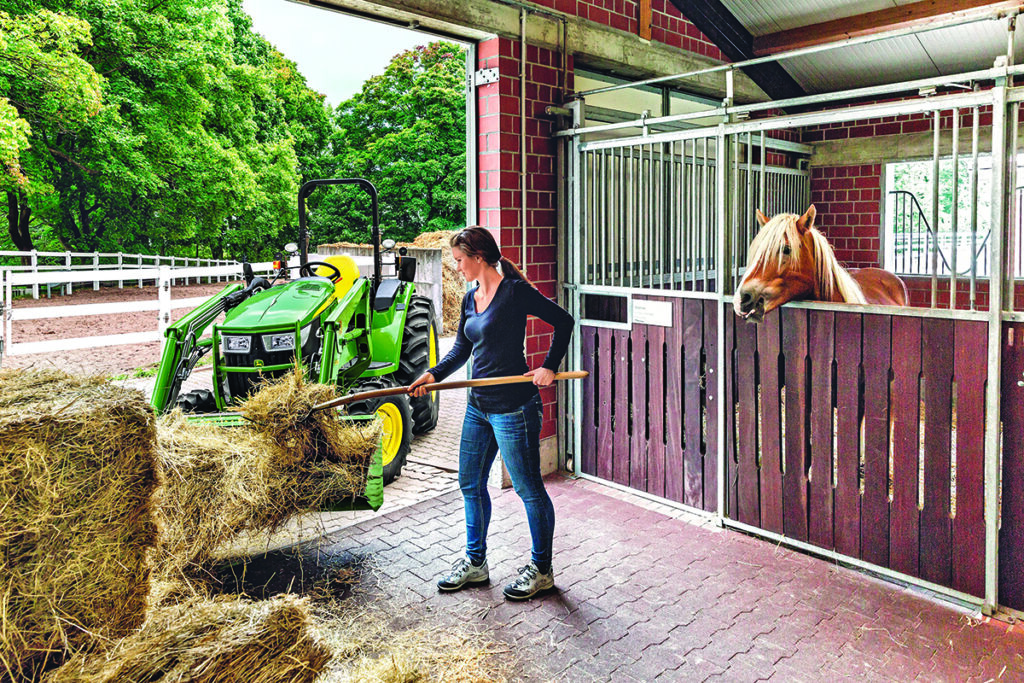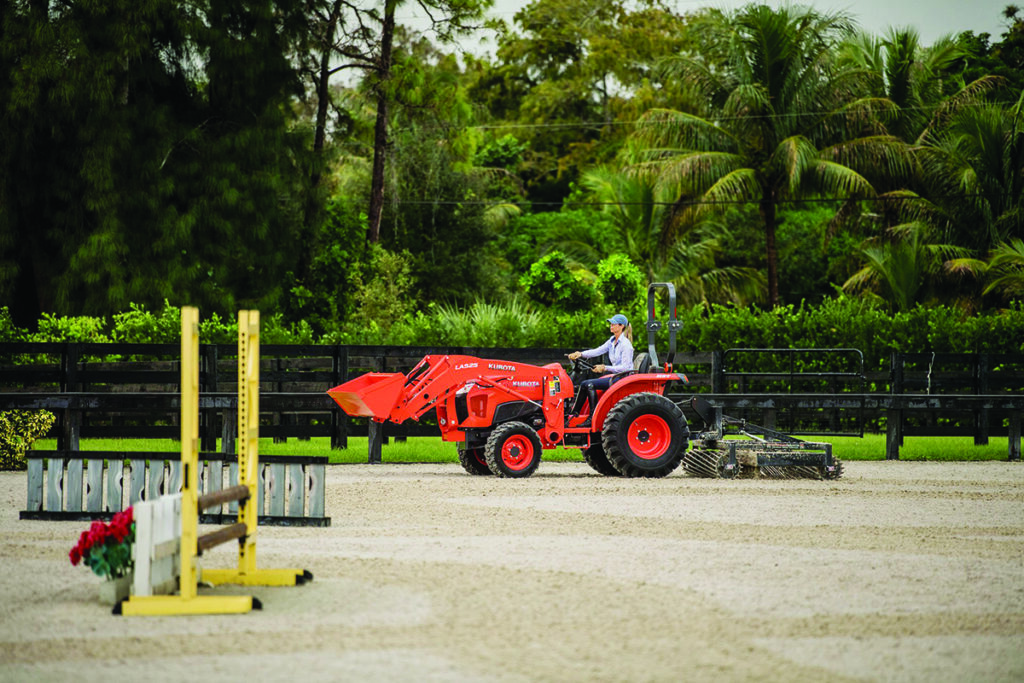Even small tractors are a big investment, so it’s important to get the right size tractor for the work you need to get done. Horsepower is what puts the giddyup in a compact tractor, but don’t get too tied up in horsepower hype. You also need to consider size, weight and overall capabilities when selecting a tractor for horse property.

Smaller Tractors
“Subcompact utility tractors are the smallest class of tractors, which usually have less than 20 PTO horsepower and are normally used with 4-foot implements,” says Jeremy Linder, general manager of Ag-Bag Forage Solutions in Astoria, Ore. “Compact utility tractors have a broader definition, but they usually have 20 to 40 PTO horsepower and are capable of running larger 5-foot or 6-foot implements. For a lot of consumers, it’s about the tradeoff between the purchase cost of the equipment and time. The smaller subcompacts can accomplish the same tasks, but they won’t be as efficient as the larger compacts.”
A subcompact is just a little larger than the biggest lawn tractors, but it has a diesel engine and a three-point hitch, according to Mike Wiles, who is known as “Tractor Mike” on his YouTube channel, which targets safety and education for those just starting out with tractors. “They’re nice for smaller properties of 5 acres or less, work great in tight quarters and can be stored in the corner of a garage. A subcompact is a good first step to entering tractor ownership, but a number of them get traded for larger ones down the line.”
Is Bigger Better?
Compact tractors come in several sizes. While some manufacturers simply refer to all the different sizes as a compact utility tractor, others break down the sizes into small-frame compacts, mid-size compacts and full-size compacts. Wiles recommends that you get the biggest tractor you can afford.
Linder agrees, to a point.
“We try to match the equipment to the operation, but when there’s doubt, we recommend going larger,” he says. “We rarely have a customer that regrets buying a larger tractor to start, but we commonly have customers upgrading to a larger unit a few years down the road. We advise our customers to buy their second tractor first.”
Horsepower Points
How much horsepower do you really need? The short answer is you need enough to power your implements. If you buy a tractor for horse property at the bottom of the horsepower range, it may strain to complete everyday tasks, which can cause your tractor to break down and cause frequent, expensive repairs.

The more horsepower a compact tractor has, the more you can pull and haul. Therefore, choose horsepower based on your tasks, the implements required to complete those tasks, and how quickly you want to get those tasks done.
In Wiles’ experience, the implement that trips more people up is the brush hog, or rotary cutter.
“New customers will purchase a 35-horsepower tractor, which seems big, and a 6-foot cutter, he says. “But a couple of years down the line, they decide they want to get their pastures mowed quicker and want a 12-foot batwing cutter and discover they don’t have enough power to pull it. Also, if you have any thoughts of putting up hay later, you definitely want a larger tractor. Disc mowers and round balers require a lot of horsepower.”
Horsepower and Tractor Weight
When comparing horsepower, remember that engine horsepower and PTO horsepower aren’t the same things. Engine horsepower is the power a tractor has without anything connected to it, while PTO horsepower is what’s available to operate implements. Always make sure the tractor has enough PTO horsepower to work with.
“Any PTO-powered implement will have a required horsepower and that refers to PTO horsepower, not the engine horsepower,” says Wiles.
Still, there’s more to safe operation, warns Linder.
“Horsepower alone shouldn’t drive the decision toward a specific model, because the weight of the tractor is just as important,” he says. “If you need a tractor that can safely move 1,000 pounds, don’t buy something that can’t. A larger implement will require more horsepower and more weight to operate safely. For example, a subcompact has enough horsepower to operate a 5-foot rotary cutter, but it isn’t heavy enough to do it safely.”
Safety First
No matter what size and type of compact tractor you end up buying, always put safety first. Even small tractors can be dangerous, maybe even more so. Compact tractors are smaller and lighter weight, which makes them easier to operate, but also puts you at greater risk, especially from rollovers due to heavy loads that make the tractor top-heavy.
“Accidents can happen in the blink of an eye, especially to new operators,” Wiles warns. “If you’ve never operated a tractor and are buying your first one, get tractor operational safety training before you ever get in the seat and turn the key.”
Visit www.youtube.com/tractormike to see his safety video playlist.
Adding ImplementsEven if you don’t think you need any attachments for your tractor now, you should buy a model that’s compatible with a variety of implements you may need later. Some common implements used by horse owners include:  “If you’re buying a new tractor, always get a front-end loader with it,” says tractor expert Mike Wiles of the Tractor Mike YouTube channel. “You’ll use it more than you think, and the resale value will more than justify the expense. After that, most tractors get sold with brush hogs for mowing pastures. If you have a gravel driveway, get a box blade to keep the crown down, and in areas that get some snow, but not a lot, get an angle blade to move it off the driveway. Those are good to start with.” |
This article about tractors for horse property originally appeared in the September 2022 issue of Horse Illustrated magazine. Click here to subscribe!





